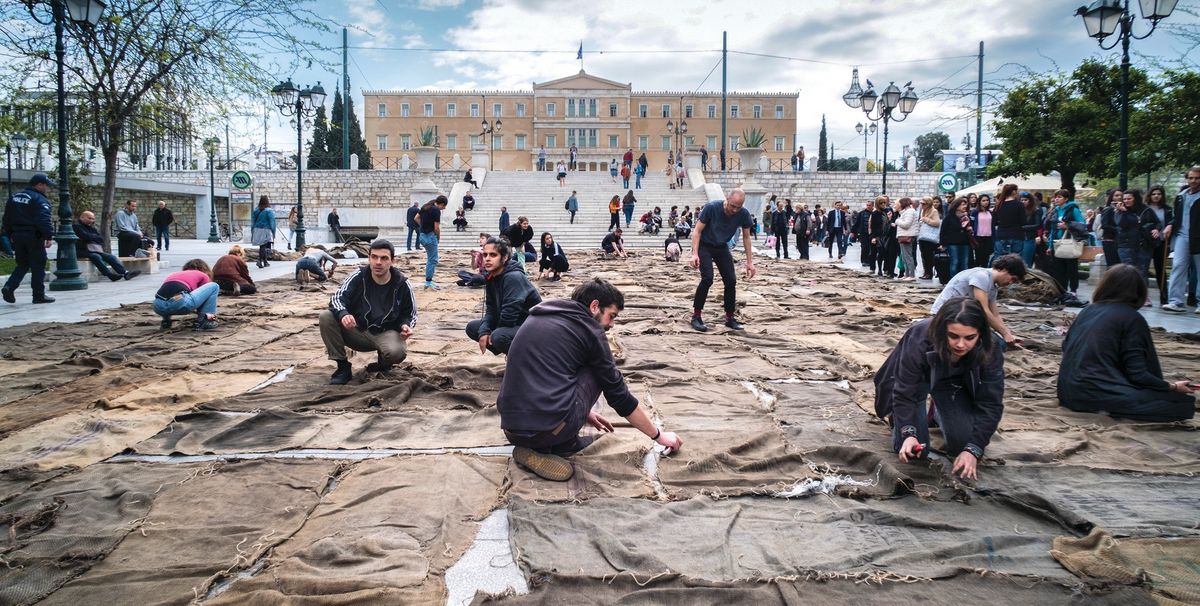For the first time in its 60-year history, the contemporary art survey Documenta has opened outside the German city of Kassel. In April the prestigious exhibition, which takes place every five years, opened the first half of its latest edition in Athens; the second part will launch in Kassel on 10 June. The idea of having two locations for Documenta is the innovation of the artistic director Adam Szymczyk.
Both sections of the event are equally important, stresses Szymczyk. Previous artistic directors have also attempted a move away from Kassel—with parallel events taking place in Kabul in Afghanistan, Banff in Canada and Alexandria in Egypt—but the scope of this year’s dual programme is unprecedented. From the moment Szymczyk was appointed in 2013, he has been insistent on inviting the 160 participating artists to create works for both cities.
The aim of the Greek exhibition, entitled Learning from Athens (until 16 July; the Kassel show runs until 17 September), is to encourage viewers to “unlearn what we know” and to “immerse ourselves in the darkness of not knowing instead of pretending to know enough in advance”, Szymczyk said at the press conference in the Greek city on 6 April. The idea is to challenge preconceptions and disrupt the status quo. To this end, Documenta 14 puts lesser-known artists from far-flung countries to the fore and features fewer market darlings. “By bringing indigenous practices from all over the world, we aim to question this very supremacist, white and male, nationalist, colonialist way of being and thinking that continues to construct the world order,” Szymczyk writes in the Documenta catalogue.
The title has attracted criticism from Greek artists, however, who feel that Documenta 14 has failed adequately to engage with the Athenian art scene. Pasqua Vorgia, an Athens-based artist and member of the collective Depression Era, says: “Not enough effort went into making new discoveries, looking at local artists or grassroots initiatives.” The sentiment is echoed by the Greek photographer Panos Kokkinias: “The title might refer to different aspects of Athens, but why would you specifically exclude art production from this learning when Documenta is an art exhibition?”
Szymczyk responded to the criticism by telling German media that the exhibition “was never meant to be a representation of the Athenian art scene. Others are supposed to do that.” He said: “We were not specifically interested in the artistic scene of Athens, but rather in the city as a living organism. And this goes beyond contemporary art. The requirement to connect with the Athenian art scene would be too narrow for this Documenta.”
However, even within local artistic circles, the Documenta team has been praised for its deep involvement with Athenian state museums. The exhibition is on show at around 40 mainly public institutions, in a bid to give “more life” to places that are struggling in the debt crisis, Szymczyk says. Sites include the Athens Conservatoire, the Athens School of Fine Arts, the Numismatic Museum and the First Cemetery of Athens, one of the many sites where the US artist Pope.L is staging his Whispering Campaign (2016-17), a sound installation dotted across the city. The central venue is the National Museum of Contemporary Art (EMST), founded in 1997 but only partially opened late last year. In exchange for hosting the show, EMST will send part of its permanent collection to Kassel, where it will be on show at the Fridericianum over the course of Documenta 14.
Visitors to EMST are greeted by a large container of olives titled Payment of Greek Debt to Germany with Olives and Art (2017) by the Argentinian artist Marta Minujin. In Kassel, Minujin will be restaging her 1983 work The Parthenon of Books, a huge replica of the Acropolis made from 100,000 books banned in various countries at different times.
There is performance art in abundance, reflecting Szymczyk’s comments that the show is “against the privileging of the object, flat-on-the-wall or three- dimensional [works]”. Performances range from the Haitian choreographer Kettly Noël’s ballet, Zombification, through Ibrahim Mahama’s Check Point Prosfygika, to Rasheed Araeen’s crowd pleaser Shamiyaana—Food for Thought: Thought for Change, in which the public is invited to eat a meal under a traditional Pakistani wedding tent.
In Kassel, German history will be a focus. In addition to Minujin’s Acropolis of banned books, which will be erected on Friedrichsplatz, the site of Nazi book burnings in 1933, other announced projects include Maria Eichhorn’s Rose Valland Institute project, which “searches and documents the expropriation of Europe’s Jewish population as well as its past and continuing themes”. Several works at the city’s Neue Galerie will respond to the discovery of Cornelius Gurlitt’s art hoard. Much of the collection, which was handed down to Cornelius by his Nazi-era art dealer father Hildebrand, is suspected to include Nazi loot. In 2015, Szymczyk announced his intention to show the entire collection, but legal procedures prevented this.


